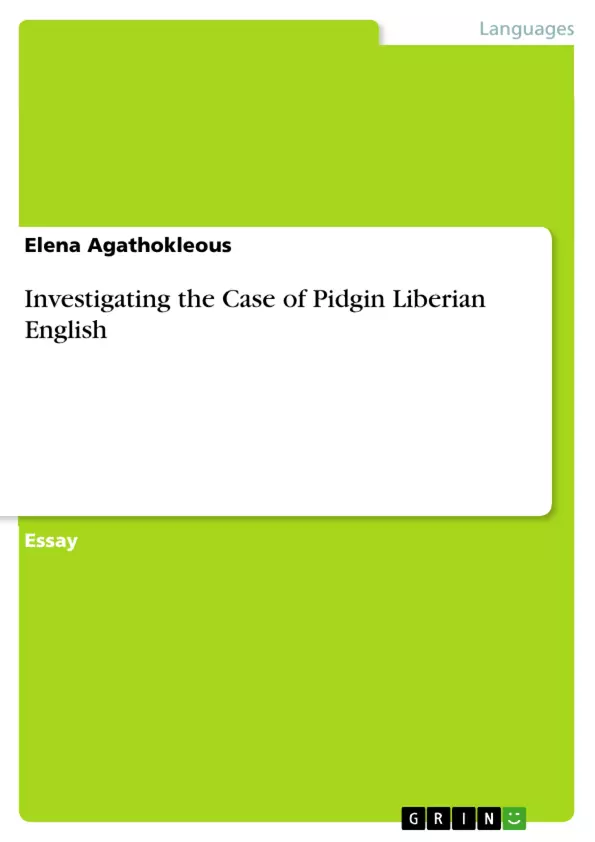The paper discusses the formation of pidgin Liberian English. A Pidgin language is a language created from the need of people with different native languages to communicate. Pidgin languages are often created to serve one specific purpose. Most often a Pidgin facilitates people that want to trade or serves as a way of understanding between settlers and natives in cases of colonization. A Pidgin language is one that has no native speakers. If it acquires native speakers by children growing up having the specific language as their native language, then it is categorized as a Creole language.
Table of Contents
- Introduction to Pidgin Languages
- Liberian Pidgin English: Origins and Development
- Grammatical Features of Liberian Pidgin English
- Social Perception and Use of Liberian Pidgin English
Objectives and Key Themes
This text aims to provide a comprehensive overview of Liberian Pidgin English (LPE), exploring its origins, development, grammatical features, and its social perception within Liberia. It examines LPE's position as a vital communication tool in a multilingual context, analyzing its unique linguistic characteristics and its relationship to both the superstrate (English) and substrate (Liberian languages).
- The formation and evolution of Pidgin languages
- The linguistic features of Liberian Pidgin English
- The sociolinguistic context of LPE within Liberia
- The influence of various languages on LPE's development
- The social perception and status of LPE
Chapter Summaries
Introduction to Pidgin Languages: This section defines Pidgin languages as languages created to facilitate communication between people speaking different native languages. It discusses their typical purpose (often trade or inter-colonial communication), their lack of native speakers (distinguishing them from Creole languages), and various theories regarding the etymology of the word "Pidgin." It highlights the influence of superstrate and substrate languages on the vocabulary and grammar of Pidgins, explaining the typical simplicity of their structure and the frequent presence of polysemy. The introduction lays the groundwork for understanding the specific characteristics of Liberian Pidgin English within the broader context of Pidgin language development.
Liberian Pidgin English: Origins and Development: This chapter delves into the historical development of Liberian Pidgin English (LPE), tracing its origins to the need for trade communication between Europeans, Americans, and indigenous Liberians. The text details the diverse influences shaping LPE, including the languages of various traders, the prestigious Standard American English spoken by elite immigrant communities, and the indigenous Liberian languages themselves. It highlights the significant role of "Krumen" (sailors) in spreading LPE along the coast, enriching its vocabulary with American and European influences. The chapter emphasizes the predominantly English vocabulary (around 90%) while noting the significant impact of West African languages on pronunciation and the creation of unique idioms.
Grammatical Features of Liberian Pidgin English: This section focuses on the grammatical characteristics of LPE, contrasting it with Standard English. It discusses the absence of grammatical inflections, the lack of affixes, the inconsistent use of determiners, and the distinct treatment of pronouns. The chapter examines LPE's unique tense system (lack of simple past tense, use of "de" for progressive tense), negation strategies, and prepositional usage. It highlights how LPE’s grammar reflects a greater affinity to the indigenous languages of Liberia than to Standard English, demonstrating the powerful influence of the substrate languages on grammatical structure. This section provides a detailed analysis of the grammatical features that distinguish LPE from Standard English.
Social Perception and Use of Liberian Pidgin English: This chapter explores the social perception and usage of LPE in Liberia. It discusses the common negative view of Pidgin languages as "bad English" and the resulting misunderstandings between speakers of LPE and those who speak Standard English. The chapter describes the historical and ongoing stigmatization of LPE and its speakers, particularly by those who consider themselves linguistically superior. However, despite this negative perception, the chapter shows the increasing use of LPE in various contexts, leading eventually to its acquisition of native speakers— a crucial step in its evolution toward a Creole language. This analysis highlights the complex interplay between linguistic prejudice and the practical usage of LPE in everyday life within Liberia.
Keywords
Liberian Pidgin English, Pidgin languages, Creole languages, language contact, superstrate, substrate, sociolinguistics, language evolution, grammatical features, polysemy, West African languages, English language, language attitudes, language variation.
Frequently Asked Questions: Liberian Pidgin English
What is the purpose of this text?
This text provides a comprehensive overview of Liberian Pidgin English (LPE), covering its origins, development, grammatical features, and social perception within Liberia. It explores LPE's role as a vital communication tool in a multilingual context and analyzes its unique linguistic characteristics and relationship to English and Liberian languages.
What topics are covered in the text?
The text covers the following key areas: the formation and evolution of Pidgin languages in general; the specific linguistic features of Liberian Pidgin English; the sociolinguistic context of LPE in Liberia; the influence of various languages on LPE's development; and the social perception and status of LPE.
What are the main chapters and their content?
The text is structured into four chapters:
- Introduction to Pidgin Languages: Defines Pidgin languages, discusses their origins and characteristics, and explains the concepts of superstrate and substrate languages.
- Liberian Pidgin English: Origins and Development: Traces the historical development of LPE, highlighting the influences of European, American, and indigenous Liberian languages.
- Grammatical Features of Liberian Pidgin English: Analyzes the grammatical characteristics of LPE, comparing them to Standard English and emphasizing the influence of substrate languages.
- Social Perception and Use of Liberian Pidgin English: Explores the social perception and usage of LPE in Liberia, including the stigma associated with it and its increasing use in various contexts.
What are the key grammatical features of Liberian Pidgin English?
Key grammatical features of LPE include the absence of grammatical inflections and affixes, inconsistent use of determiners, distinct treatment of pronouns, a unique tense system (lack of simple past tense, use of "de" for progressive tense), specific negation strategies, and particular prepositional usage. These features show a stronger connection to Liberian indigenous languages than to Standard English.
What is the social status of Liberian Pidgin English?
LPE faces historical and ongoing stigmatization, often viewed negatively as "bad English." However, despite this negative perception, its usage is increasing in various contexts, leading to its acquisition by native speakers, a step towards its evolution into a Creole language. The text highlights the complex relationship between linguistic prejudice and the practical use of LPE in Liberia.
What are the key words associated with this text?
Key words include: Liberian Pidgin English, Pidgin languages, Creole languages, language contact, superstrate, substrate, sociolinguistics, language evolution, grammatical features, polysemy, West African languages, English language, language attitudes, and language variation.
For whom is this text intended?
This text is intended for academic use, providing a structured analysis of themes related to Liberian Pidgin English for researchers and students studying linguistics, sociolinguistics, and related fields.
- Quote paper
- Elena Agathokleous (Author), 2018, Investigating the Case of Pidgin Liberian English, Munich, GRIN Verlag, https://www.grin.com/document/995916




